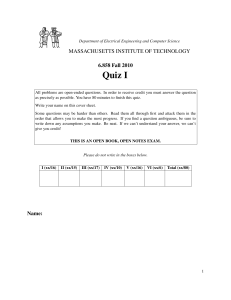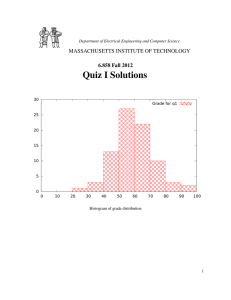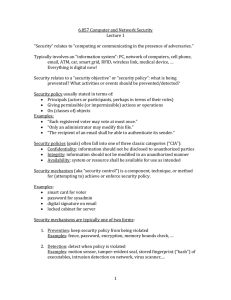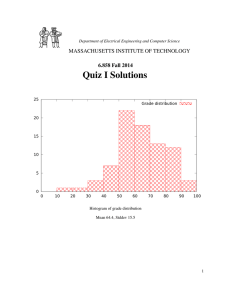Quiz I MASSACHUSETTS INSTITUTE OF TECHNOLOGY 6.858 Fall 2012
advertisement
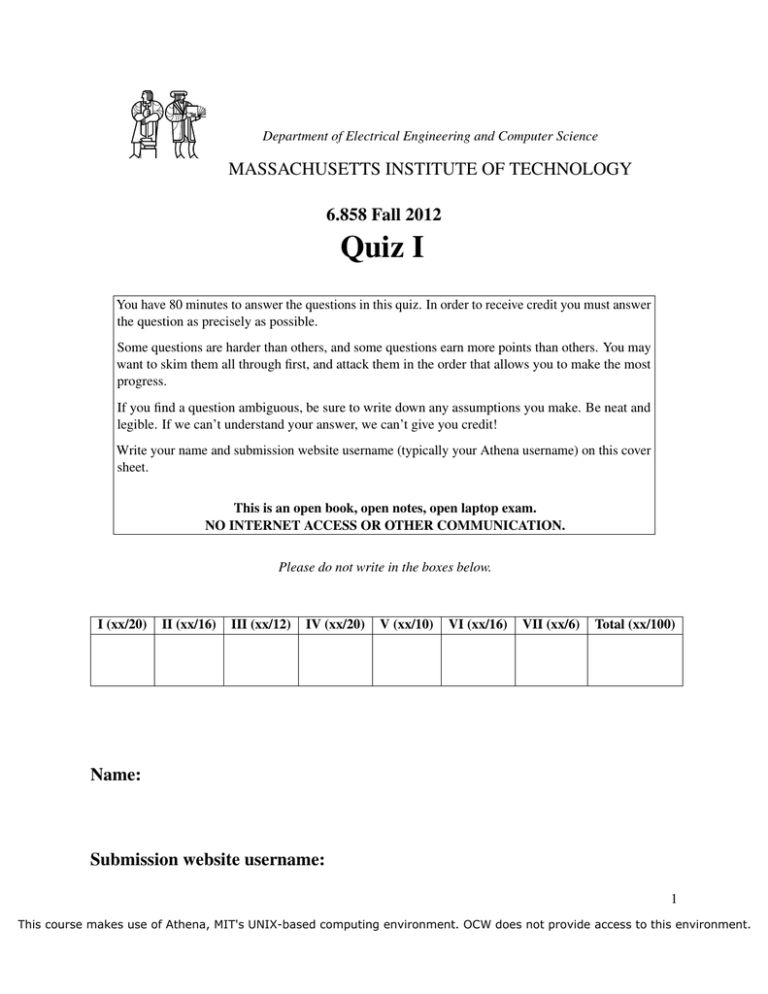
Department of Electrical Engineering and Computer Science
MASSACHUSETTS INSTITUTE OF TECHNOLOGY
6.858 Fall 2012
Quiz I
You have 80 minutes to answer the questions in this quiz. In order to receive credit you must answer
the question as precisely as possible.
Some questions are harder than others, and some questions earn more points than others. You may
want to skim them all through first, and attack them in the order that allows you to make the most
progress.
If you find a question ambiguous, be sure to write down any assumptions you make. Be neat and
legible. If we can’t understand your answer, we can’t give you credit!
Write your name and submission website username (typically your Athena username) on this cover
sheet.
This is an open book, open notes, open laptop exam.
NO INTERNET ACCESS OR OTHER COMMUNICATION.
Please do not write in the boxes below.
I (xx/20)
II (xx/16)
III (xx/12)
IV (xx/20)
V (xx/10)
VI (xx/16)
VII (xx/6)
Total (xx/100)
Name:
Submission website username:
1
This course makes use of Athena, MIT's UNIX-based computing environment. OCW does not provide access to this environment.
I
Buffer overflows
Consider the following C program, where an adversary can supply arbitrary input on stdin. Assume no
compiler optimizations, and assume a 32-bit system. In this example, fgets() never writes past the end of
the 256-byte buf, and always makes it NULL-terminated.
int main() {
char buf[256];
fgets(buf, 256, stdin);
foo(buf);
printf("Hello world.\n");
}
1. [12 points]: Suppose the foo function is as follows:
void foo(char *buf) {
char tmp[200]; // assume compiler places "tmp" on the stack
// copy from buf to tmp
int i = 0;
// assume compiler places "i" in a register
while (buf[i] != 0) {
tmp[i] = buf[i];
i++;
}
}
Which of the following are true? Assume there is an unmapped page both above and below the stack in
the process’s virtual memory.
(Circle True or False for each choice.)
A. True / False
down.
An adversary can trick the program to delete files on a system where the stack grows
B. True / False
up.
An adversary can trick the program to delete files on a system where the stack grows
C. True / False An adversary can trick the program to delete files on a system using Baggy bounds
checking with slot_size=16. (Stack grows down.)
D. True / False An adversary can prevent the program from printing “Hello world” on a system using
Baggy bounds checking with slot_size=16. (Stack grows down.)
E. True / False An adversary can trick the program to delete files on a system using terminator stack
canaries for return addresses. (Stack grows down.)
F. True / False An adversary can prevent the program from printing “Hello world” on a system using
terminator stack canaries for return addresses. (Stack grows down.)
2
2. [8 points]: Suppose the foo function is as follows:
struct request {
void (*f)(void);
char path[240];
};
// function pointer
void foo(char *buf) {
struct request r;
r.f = /* some legitimate function */;
strcpy(r.path, buf);
r.f();
}
Which of the following are true?
(Circle True or False for each choice.)
A. True / False An adversary can trick the program to delete files on a system where the stack grows
down.
B. True / False An adversary can trick the program to delete files on a system where the stack grows
up.
C. True / False An adversary can trick the program to delete files on a system using Baggy bounds
checking with slot_size=16. Assume strcpy is compiled with Baggy. (Stack grows down.)
D. True / False An adversary can prevent the program from printing “Hello world” on a system using
Baggy bounds checking with slot_size=16. Assume strcpy is compiled with Baggy. (Stack grows
down.)
3
II
OS sandboxing
Ben Bitdiddle is modifying OKWS to use Capsicum. To start each service, Ben’s okld forks, opens the
service executable binary, then calls cap_enter() to enter capability mode in that process, and finally
executes the service binary. Each service gets file descriptors only for sockets connected to okd, and for TCP
connections to the relevant database proxies.
3. [6 points]: Which of the following changes are safe now that the services are running under
Capsicum, assuming the kernel implements Capsicum perfectly and has no other bugs?
(Circle True or False for each choice.)
A. True / False
It is safe to run all services with the same UID/GID.
B. True / False
It is safe to run services without chroot.
C. True / False It is safe to also give each service an open file descriptor for a per-service directory
/cores/servicename.
4
Ben also considers replacing the oklogd component with a single log file, and giving each service a file
descriptor to write to the log file.
4. [5 points]: What should okld do to ensure one service cannot read or overwrite log entries from
another service? Be as specific as possible.
5. [5 points]: What advantages could an oklogd-based design have over giving each service a file
descriptor to the log file?
5
III
Network protocols
Ben Bitdiddle is designing a file server that clients connect to over the network, and is considering using
either Kerberos (as described in the paper) or SSL/TLS (without client certificates, where users authenticate
using passwords) for protecting a client’s network connection to the file server. For this question, assume
users choose hard-to-guess passwords.
6. [6 points]: Would Ben’s system remain secure if an adversary learns the server’s private key, but
that adversary controls only a single machine (on the adversary’s own home network), and does not
collude with anyone else? Discuss both for Kerberos and for SSL/TLS.
7. [6 points]: Suppose an adversary learns the server’s private key as above, and the adversary
also controls some network routers. Ben learns of this before the adversary has a chance to take any
action. How can Ben prevent the adversary from mounting attacks that take advantage of the server’s
private key (e.g., not a denial-of-service attack), and when will the system be secure? Discuss both for
Kerberos and for SSL/TLS.
6
IV
Static analysis
Would Yichen Xie’s PHP static analysis tool for SQL injection bugs, as described in the paper, flag a potential
error/warning in the following short but complete PHP applications?
8. [10 points]:
A. True / False
The tool would report a potential error/warning in the following code:
function q($s) {
return mysql_query($s);
}
$x = $_GET[’id’];
q("SELECT .. $x");
B. True / False
The tool would report a potential error/warning in the following code:
function my_validate() {
return isnumeric($_GET[’id’]);
}
$x = $_GET[’id’];
if (my_validate()) {
mysql_query("SELECT .. $x");
}
7
9. [10 points]:
A. True / False
The tool would report a potential error/warning in the following code:
mysql_query("SELECT .. $n");
B. True / False
The tool would report a potential error/warning in the following code:
function check_arg($n) {
$v = $_GET[$n];
return isnumeric($v);
}
$x = $_GET[’id’];
if (check_arg(’id’)) {
mysql_query("SELECT .. $x");
}
8
V
Runtime instrumentation
10. [10 points]:
Consider the following Javascript code:
function foo(x, y) {
return x + y;
}
var a = 2;
eval("foo(a, a)");
var p_c = {
k: 5,
f: function() { return a + this.k; }
};
var kk = ’k’;
p_c[kk] = 6;
p_c.f();
Based on the description in the paper by Sergio Maffeis et al, and based on lecture 9, what will be the
FBJS rewritten version of this code, assuming the application-specific prefix is p_?
9
VI
Browser security
Ben Bitdiddle is taking 6.858. Once he’s done with his lab at 4:55pm, he rushes to submit it by going to
https://taesoo.scripts.mit.edu/submit/handin.py/student, selecting his labN-handin.tar.gz
file, and clicking “Submit”. The 6.858 submission web site also allows a student to download a copy of their
past submission.
For your reference, when the user logs in, the submission web site stores a cookie in the user’s browser to
keep track of their user name. To prevent a user from constructing their own cookie, or arbitrarily changing
the value of an existing cookie, the server includes a signature/MAC of the cookie’s value in the cookie, and
checks the signature when a new request comes in. Finally, users can log out by clicking on the “Logout”
link, https://taesoo.scripts.mit.edu/submit/handin.py/logout, which clears the cookie.
Alyssa P. Hacker, an enterprising 6.858 student, doesn’t want to do lab 5, and wants to get a copy of Ben’s
upcoming lab 5 submission instead. Alyssa has her own web site at https://alyssa.scripts.mit.edu/,
and can convince Ben to visit that site at any point.
11. [16 points]: How can Alyssa get a copy of Ben’s lab 5 submission?
Alyssa’s attack should rely only on the Same-Origin Policy. Assume there are no bugs in any software,
Ben’s (and Taesoo’s) password is unguessable, the cookie signature scheme is secure, etc.
10
VII
6.858
We’d like to hear your opinions about 6.858. Any answer, except no answer, will receive full credit.
12. [2 points]: This year we started using Piazza for questions and feedback. Did you find it useful,
and how could it be improved?
13. [2 points]: What aspects of the labs were most time-consuming? How can we make them less
tedious?
14. [2 points]: Are there other things you’d like to see improved in the second half of the semester?
End of Quiz
11
MIT OpenCourseWare
http://ocw.mit.edu
6.858 Computer Systems Security
Fall 2014
For information about citing these materials or our Terms of Use, visit: http://ocw.mit.edu/terms.


